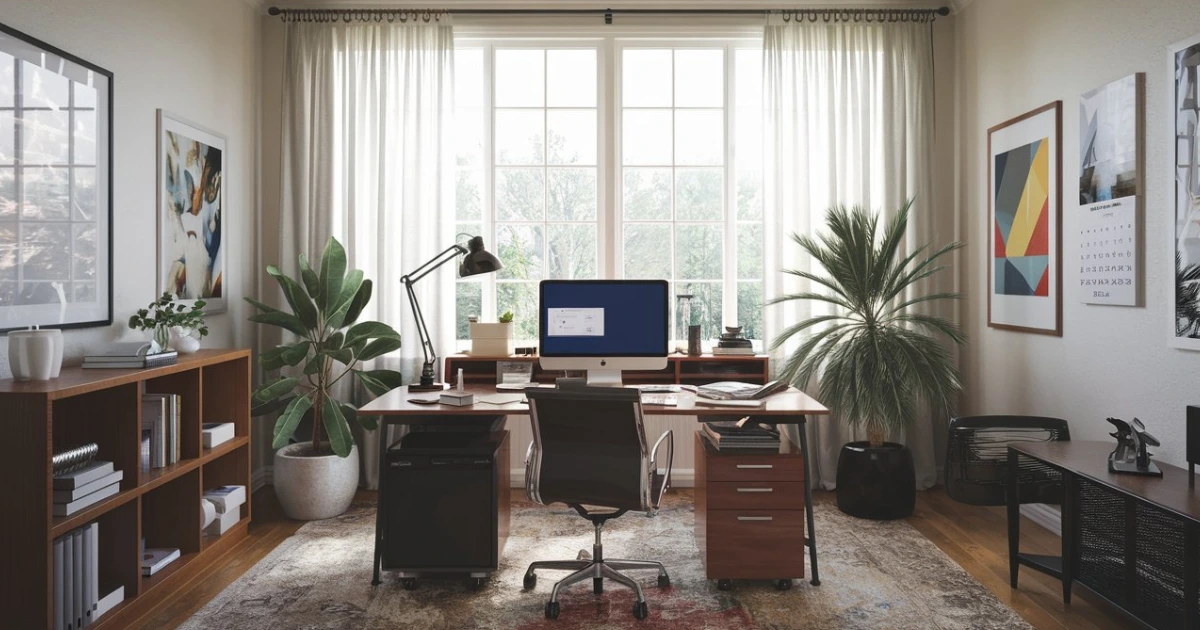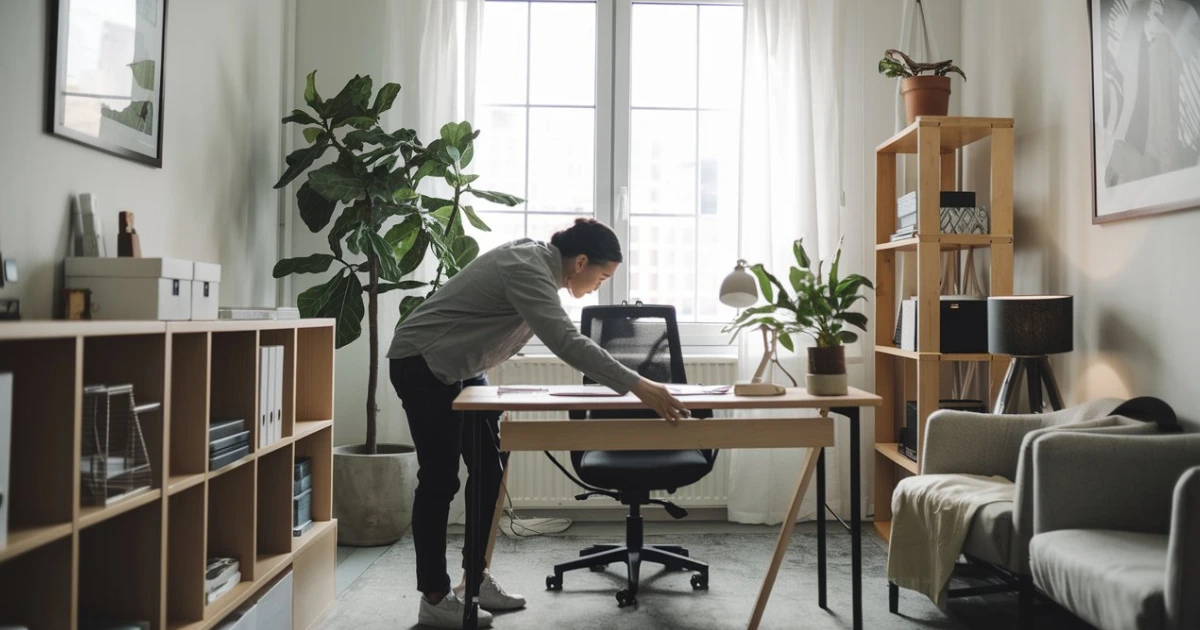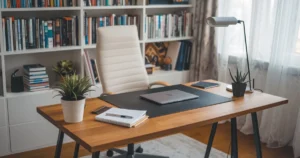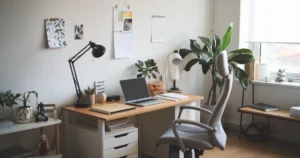The new face of remote work has dramatically shifted how we approach our professional lives. As regards this, the home office has been the talk of the town or rather the home in getting everything done perfectly. With the large number of people working from home these days, a dedicated, Productive Home Office Setup space is definitely there to ensure that one is able to stay on the same level of focus and efficiency and balance that depicts growth in oneself. The right home office setup increases your productivity and helps you keep better mental and physical health by clearly demarcating work and personal life. Irrespective of your schedule for remote work-full time, three to four days, or as many as two – being rightly placed in the right kind of space will enhance your overall experience and work results considerably.

Choosing the Right Space: Crafting Your Ideal Home Office
The first key step of creating a Productive Home Office Setup office involves creating the right space. A good workspace has much to do with how focused and efficient you remain throughout the day. The ability to have a good work-life balance and to be even more productive can be ensured by having a quiet, dedicated spot for work as it minimizes the distractions.
Importance of Quiet, Dedicated Workspace
There may be thousands of distractions ranging from mere household noises to the constant interruption by family members; hence, a work space must be demarcated. The quieter and more secluded the environment, the better you will be in setting boundaries and signaling to others that you are in “work mode” and should not be disturbed. A dedicated workspace also helps to reinforce the mental separation of work and home, so you can concentrate during work hours and relax when you’re stepping away. Ideally, this space should be clear of all high-traffic areas within your home: kitchen or living room, for example, in order to minimize all kinds of interruptions.
Choosing a Location with Natural Light
Natural lighting can play a huge role in the mood, energy, and productivity level. When choosing a place for your home office, please select places that are by the windows because there will be ample natural light. The light from the sun can also help regulate a body’s circadian rhythms and might become a boon to concentrate on and feel well during the day. Because well-lit spaces minimize eye fatigue, it makes it possible to work for longer hours. If there is no natural light in the space you chose, then add soft task lighting or daylight bulbs to make the space bright and welcoming.
Away from Distractions
Noise aside, there are also visual distractions that’ll carry your focus out of work. You’ll want a space without distractions existing in the background. For instance, avoid the space where you’ll do your work facing your television, your phone, or any of the major traffic points in the house. Position your desk so it won’t be conspicuous to distracting views, and keep the workspace minimal and arranged for a clear environment with clear focus.
Small Space Considerations
If you don’t have space, there’s no need to worry-you can still create a productive home office. There are plenty of spaces to utilize, such as corners, closets, or multi-purpose areas in the home. For instance, even a very small desk or wall-mounted workspace can easily change an unused corner of a room into a legitimate office. In case you’re working in a common space, like over the dining room or living area, then maybe the best option would be using room dividers, or you can temporarily set it up and instantly pack it away. Or, you can add vertical storage solutions, like shelves, pegboards, and organizers attached to the walls, for clear floor space that prevents clutter.
Ergonomics Matter: Creating a Comfortable and Productive Home Office
Ergonomics refers to the designing of a working environment to comfort, efficiency, and well-being. In brief, it’s about how your setup works with your body instead of against it-for a minimum risk of injury but maximum productivity. Over recent years, with increased remote working, individuals spend many more hours in their chairs. Proper ergonomics will discourage the above conditions and result in pains such as back and neck strains and repetitive stress injuries. A good ergonomic home office design will not only make someone comfortable but also concentrate, energetic, and proficient in work.
Ergonomic Chair
The chair forms the backbone of an ergonomic workspace. An ergonomic chair should offer lower back support, promote good posture, and be adjustable to accommodate your body’s needs. A chair with back support is a requirement that will maintain one natural curve of the spine. The sitting space should be arranged such that the chairs are set at a height that enables placing the feet flat on the floor but maintains an almost 90 degrees angle between the knee and leg. Armrests must provide arm support and at the same time keep shoulders relaxed. For extended use, a well-cushioned seat cushion and breathable material.
Desk height and monitor setting
The other vital element of an ergonomic setup is the height of your desk. Ideally, this desk should position you so that your arms are bent at 90 degrees while your wrists remain straight and parallel to your forearms. A desk that is too high or too low can lead to discomfort or strain over time.
Position your monitor at about 20-30 inches from your face to not strain your neck. In the case where your monitor is positioned too low, you will end up leaning forward and thus create a poor posture. Take into consideration using monitor stand or even an adjustable desk to set your screen at the right height. In case you are using several monitors, position them all leveled at the same height such that you don’t have to twist or turn to see what you want.
Ergonomic Accessories
Ergonomic accessories help improve on comfort and productivity even further. Generally, an ergonomic keyboard and mouse are comfortable for the wrists as well as hands by eliminating aching problems associated with carpal tunnel syndrome. A keyboard should allow your wrists to stay in a neutral position, keeping your hands lower than at elbow level. You should look for a key board that is either divided or curved.
Another good accessory is a footrest. The latter will be helpful if your chair is a bit too high to elevate your feet comfortably on the floor. With a footrest, you will maintain proper posture by means of supported feet and knees at a 90-degree angle.
You can use extra cushioning via a seat cushion or backrest pillow that supports your lumbar region but leaves less weight on the lower back. Such minute adjustments sometimes make all the difference when you need comfort especially during a long working day.
Lighting for Productivity: How to Optimize Your Home Office
Lighting of a home office affects quite a high degree of your focus, mood, and productivity. Dim lighting would trigger the sufferings which involve eye strain and headache for dark conditions. Bright light, on the other hand, enhances your concentration, uplifts your mood, and energizes you. Proper balance between natural and artificial lighting is necessary in a workplace to keep one motivated and productive throughout the day. Impact of Lighting on Focus and Mood

The effects of light on our mental and physical lives have its own biological influence. Sometimes, too little or too much lighting is irritating and you could not fully focus on your work, eventually killing time-scale in accomplishing work. Not enough lighting may promote sleepiness and low energy; however, lighting that is too intense, especially from overhead lights, is uncongenial and inhibits creativity, promoting a sterile atmosphere.
Natural daylight might be the best natural source for keeping alert and cheerful. Exposure to natural daylight generally aids in regulating your circadian rhythms that control your sleep-wake cycle. It also helps improve moods by producing serotonin that helps reduce stress and anxiety. Thus, optimal positioning of your home office to maximize the use of natural light can make a lot of difference both to your productivity and well-being.
Make the Most of Natural Light
Position your desk near a window to utilize natural light. Ensure that this source of light is not behind or in front of the monitor to avoid glare and blurry vision. Positioning your desk at an angle perpendicular to the window will produce the same effect without the nuisance of glare from a light source.
In case natural light access is restricted, using mirrors can also do the trick: place some mirrors in positions that will reflect some sunlight towards the work area. Lighter colored walls can reflect natural light within the room and make a space seem brighter and more expansive by bouncing light off walls and around the room.
Using Task Lighting
Task lighting illuminates your workspace whenever natural light is not sufficient. Applying desk lamps or task lights you can modify to illuminate light at your desired location will also decrease eye strain from reading, writing, or working on the computer. The light needs to be strong enough to clearly illuminate your work while not casting too much glare or creating unflattering shadows.
Ensure that the task light has flexible lamps so you can direct it with more precision. You may use swing-arm lamps or lamps accompanied by dimmer switches. They help enable the time of day and even activities to be adjusted. Overhead lighting shouldn’t be relied on for most lighting in your office, as it can be overly intense and awkward for reading words on paper.
Selecting the Right Lamps and Light Bulbs
The lamps and light bulbs chosen can really make the big difference in your home office environment. You will be looking for lamps that offer adjustable brightness or colors by being able to change color temperatures. LED bulbs are a very ideal option for any kind of office use because they are energy-efficient, last longer, and are available in a wide range of color temperatures.
For offices, daylight or cool white bulb 5000K to 6500K should be used as these will more closely approximate natural light, making you more alert and clearheaded. Warm white bulbs in the range 2700K to 3000K are better for relaxation areas, as they promote a cozy feeling. Dimmable bulbs also allow you flexibility as you may be required at different hours during the day to perform certain tasks or if your lighting needs differ for different tasks.
Declutter and Organize: Creating a Clean and Efficient Workspace
A cluttered office is one thing that can immensely reduce your productivity levels. The clutter will also make it full of distractions and increased levels of stress. For this reason, it becomes essential to keep the home office free from clutter and to be organized so that you can have an atmosphere that is welcoming yet productive. When the workspace is organized, you tend to have a clearer mind to help you center on what has to be done without any undulled distractions.
How to Organize Your Desk
The first step in maintaining a tidy workspace is decluttering your desk. Begin by decluttering what does not need to be there, keeping only essentials within arm’s reach. Think about getting trays and desk organizers for pens, paper, and office supplies. You will often find that a lot of space lies flat with the use of your desk. Adding shelves above or next to your desk can be a fantastic way to store documents, books, and decor while keeping the desktops clear. Store small items in drawers with the assistance of drawer dividers or small bins.
Effective Storage Solutions
An organized office is key to maintaining an efficient and incorporates smart storage solutions. Filing cabinets, labeled boxes, open shelving can all assist you to corral the important documents and tools you need when the time arises. This may set up a system where everything has a place, making it easy to track down what’s needed, at what moment. A regular routine of tidying up at the end of each workday will prevent clutter from piling up over time.
Digital Organization
Digital clutter is as distracting as physical clutter. Their computer files should be organized with a clear folder structure, and cloud services make access and sharing easier. Productivity tools such as task managers, calendars, or note-taking apps make work activities smoother. Periodic backup of files and removal of all the old and unnecessary data will make your digital space as clean as your physical space.
By maintaining an organized and decluttered workspace, you set yourself up for better productivity and a more positive work experience.
Technology and Tools for a Productive Home Office
Talking of an efficient home office, right technology and tools do play quite a mainstream role. Reliable tech ensures one goes about their business very smoothly with full connections to the team, clients, or projects anywhere around.
Must Have the Core Tech Equipments
You want to start with a good basis: internet is not a negotiable commodity as it supports your remote work. Invest in high-speed internet that can run bandwidth-heavy processes such as video calls, big file transfers, and many others. A good computer, desktop or laptop, is a significant investment, too—one that should ideally have enough processing power and memory to run several apps at once without lagging. If your job demands it, you can consider investing in a multi-monitor setup for better multitasking capabilities.
Aside from the computer, a high-quality headset and webcam will be really useful for clearer conversations if you’re meeting virtually. A noise-canceling headset gives excellent audio quality with fewer distractions, while a true HD webcam ensures you are intelligible. Consider getting a wireless keyboard and mouse to free up desk space.
Backup Solutions
Some backup solutions are often overlooked but considered crucial to safeguarding your work. An external hard drive offers a simple, tangible backup option, although cloud services such as Google Drive, Dropbox, or OneDrive ensure ease and automatic backups, allowing access from anywhere, easily and efficiently.
Regularly backing up your files can save you from the loss of all data and retain business continuity.
Productivity Apps
The right applications keep you organized and in the know about tasks to be done. You can track the work through project management tools like Trello, Asana, or ClickUp. Communication applications, such as Slack or Microsoft Teams, keep you connected with colleagues. For personal productivity, for example, you may use Evernote, Todoist, or Notion in tracking tasks, noting things down, or keeping yourself focused.
With the right technology and tools in place, your home office can be set up to maximize productivity and effectiveness.
Personalizing Your Space: Balancing Comfort, Aesthetics, and Focus
It feels comfortable and inspiring when you personalize your space, like your home office. Adding something personal, be it plants, paintings, or ornaments that reflect their personality, improves one’s mood and creativity while working in the space. For instance, indoor plants bring life and color to the workspace, and improve air quality and reduce stress. Meanwhile, artwork or inspirational quotes well chosen might inspire you for the rest of the day, and personal stuff like photographs or mementos will add a sense of familiarity to it.

But still, you have to find that balance between aesthetic and functionality because your home office should remain a space where productivity is sustained. Do not overdo it with too many personal items. A messy space becomes a superfluous distraction too soon; it begins to interfere with your ability to focus on the task. Apply décor that fits the purpose of your workspace without overpowering it. For instance, a painting or just a couple of plants strategically placed can better the ambiance of your office while retaining an attractiveness of it and making it look clean and professional.
Use the “less is more” approach if you want to keep personalization balanced. Start with some targeted items that exude calm, motivational feelings, and then add more as your judgment deems appropriate according to how the space feels over time. Generally, avoid placing things that are too distracting, such as loud colors or too many knick-knacks or things that tug your eye away from work. Keep your working environment deliberately orchestrated so that your personal touches blend well with your office tools and setup.
Balancing Comfort and Productivity
Balancing comfort in your home office brings about productivity over a long work stretch. In the same context, convenience releases more attention and minimizes fatigue, hence making it crucial to invest in components that make one feel comfortable. Elements as simple as a supportive cushion underneath the chair or a footrest can make all the difference in the way you sit and therefore relieve pressure on the back and legs. The workplace should not be so hot nor too cold as to provide a minimum of discomfort.
Although comfort is highly essential, maintaining a professional atmosphere that calls for concentration is equally important. Avoid filling your workspace with unnecessary things that may distract you. Keep the environment clean and beautiful to inspire the right mood for work. Use soothing colors and designs that invoke creativity without overwhelming the senses.
More than comfort, though, regular intermissions in your routine will ensure that you stay productive. Carefully setting up the environment to allow for brief moments of relaxation recharges the mind and enhances the capacity for focus. Consider setting a small area aside for some stretching or a quick walk to boost your energy and clear your mind. Using a timer for your periods of focused work followed by short breaks can incite productivity without sacrificing comfort.
Finally, balancing comfort and productivity in your home office setup is really a matter of creating an environment that will support your physical needs and your professional responsibilities. Through the careful introduction of comfort measures and break strategies, you can create a workspace that encourages sustained focus, creativity, and overall well-being.
Work-Life Boundaries: Establishing a Healthy Balance at Home
Sometimes, lack of clear structural lines blur the lines between your work and home. This creates lots of problems because when these boundaries are not set and promoted, it easily leads to burnout and inefficiency at home because in a remote work environment, your home becomes your office. Here’s how you can establish and maintain those borders.
- Define a Workplace
Start with setting aside a specific work area that is not your living area. This can be as mundane as a room in your house, or just a corner of your living room, or even a nook in your bedroom. By reserving a place for work, you could practically and psychically differentiate the demands of your job from other activities of your life.
- Use physical cues to “shut off” work
Physical queues, for instance, can help broadcast the end of a workday. For example, close the door to your office if you have one, or physically shut down your computer and put away the work materials. These physical queues may help instill a mental association that the end of work time has transitioned into personal time, making it easier to leave work at the office.
- Develop Routine End
Use rituals to actually determine when the work should start and end. Start using a daily ritual, for instance, a cup of coffee, a little exercise, or quick run-through of the activities you will do that day, while ending with a wind-down ritual, for instance, a short walk or reading. These can help bring some sense of clarity and make it easier to transition between work life and home life.
By using such strategies consciously you will be able to produce a healthy balance that helps you increase productivity as well as protect your personal well-being.
Work-Life Boundaries: Establishing Healthy Balance at Home
Making a clear, definitive boundary is the only way to be productive and healthy in the remote working environment. Once your home becomes your office, the lines get all fuzzy, then probably burn out and mean low efficiency. Here are some strategies that can help you determine and maintain those crucial boundaries.
- Create a Specific Workspace
Begin with a place especially for work, isolated from your living spaces. You might use an extra room, a corner of your living room, or even a niche in your bedroom. Having a special place for work, you can then use physical boundaries to separate your professional jobs from your personal life.
- Use Physical Cues to “Shut Off” Work
The use of physical signals would also serve as an end to the work. For instance, you can close your door from the office if you are allowed, or shut down and pack up the computers and all work materials and leave work. Such a culture would develop a mental relation between the time of stop and personal time, so you forget about your work.
- Cultivate routines
Routines that indicate the start and end of your workday may provide you with a sense of structure. Start the day by having a morning routine, such as a cup of coffee, a short workout session, or a review of your to-do list for the day. As a conclusion to your workday, begin with a short walk or read something for some minutes to unwind. These practices give you clarity and a mental break between work and home.
Once being aware of these actions, you can have a sound balance that increases productivity and maintains personal well-being.
Conclusion: How to Optimize Your Home Office for Success
Conclusion: A productive home office setup is a necessity for survival in today’s remote working life. The right space must be chosen, the importance of ergonomics in the situation definitely needs to be considered, lighting optimized, technology incorporated in the perfect way, and so on. Organization and personalizing the space, putting up clear boundaries between work and private life, would also prove to be essential steps toward you staying motivated and well-balanced.
We would encourage you to assess your workspace independently and make a number of minor changes that could lead to even more amazing gains in productivity. From rearranging your desk to adding ergonomic accessories and an easily followed routine for marking when the workday begins and ends, even minor adjustments can make all the difference.
We’d love to hear your tips or experiences for establishing a productive home office. Share your insights with us in the comments below and encourage one another to create the best work environment possible from the comfort of home. Your input may reach others, enabling them to improve their setup and better navigate the world of remote work!
FAQs
Why do I need a dedicated home office?
A dedicated home office, it helps separate work and personal life. It lessens distraction and enables the mental preparation to go to work.
What does my ideal home office essentially consist of?
Key elements include comfortable ergonomic chair and desk, good lighting, dependable technology, organizational tools, and personal touches that inspire motivation.
How to enhance the ergonomics of my work place?
Improving ergonomics is, first and foremost, to ensure your chair provides support to your lower back, your monitor is at eye level, you are using a keyboard and mouse supporting a neutral wrist position. If necessary, use a footrest too.
What if I have limited space for my home office?
Utilize multi-purpose furniture, such as foldable desks or storage ottomans, and create a compact workspace in a corner of a room. One can also maximize minimal space with vertical storage solutions.
How do I keep a healthy work-life balance while working from home?
Define working hours, set a particular working place, and establish some rituals of marking the beginning and end of your working day. You may also use material cues, such as turning off your computer, to mark the borderline between your work life and private life.
How do you keep yourself focused on work at home?
Put boundaries in place with family or roommates so that you won’t be distracted; play noise-cancelling headphones and develop a routine that gives you breaks to recharge.
How can I personalize my home office without setting up distractions?
Personalize the space with a few motivating items or decor- plants, artwork, etc.- but maintain an overall functional setup that’s easily organized and doesn’t cause many distractions.
What technology should be in an effective home office?
A good, reliable computer or laptop, high-speed internet, good-quality headset when needed for calls, and necessary software or tools that help with effective collaboration and task management.







